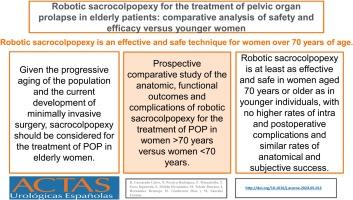Robotic sacrocolpopexy for the treatment of pelvic organ prolapse in elderly women: comparative analysis of safety and efficacy versus younger women
引用次数: 0
Abstract
Introduction
Pelvic organ prolapse is a condition with high prevalence in elderly women. With increasing life expectancy and a desire for improved quality of life, a rise in the frequency of surgical treatments for these women is anticipated. The aim is to compare complication, success, and satisfaction rates among elderly patients (aged >70 years) in comparison to younger women undergoing robotic sacrocolpopexy, thereby assessing the safety and efficacy of this surgery in this group of patients.
Method
A prospective observational comparative study of 123 robotic sacrocolpopexies conducted between December 2016 and June 2022. Patients were stratified by age (cutoff point: 70 years). Baseline characteristics, type, and grade of prolapse, intra and postoperative data, complications, functional and anatomical outcomes, and satisfaction levels were collected.
Results
Among the 123 patients, 62.6% were under 70 years old, while 37.4% were 70 years or older, exhibiting similar baseline characteristics, prolapse grade, and type. The percentages of intraoperative (6.5%) and postoperative complications (4.4–9%) were comparable in both age groups. Furthermore, success and satisfaction rates exceeded 90%, with no significant differences between women under and over 70 years during a two-year follow-up.
Conclusion
Robotic sacrocolpopexy is at least as effective and safe in women aged 70 years or older as in younger individuals, with no higher rates of intra and postoperative complications and similar rates of anatomical and subjective success.

机器人骶尾部结扎术治疗老年妇女盆腔器官脱垂:安全性和有效性与年轻妇女的比较分析。
简介盆腔器官脱垂是老年妇女的高发病。随着预期寿命的延长和对提高生活质量的渴望,预计对这些妇女进行手术治疗的频率将会增加。本研究旨在比较老年患者(年龄大于 70 岁)与年轻女性接受机器人骶尾部结扎术的并发症发生率、成功率和满意度,从而评估该手术在这类患者中的安全性和有效性:2016年12月至2022年6月期间,对123例机器人骶骨结节切除术进行了前瞻性观察比较研究。患者按年龄分层(分界点:70 岁)。研究收集了基线特征、脱垂类型和等级、术中和术后数据、并发症、功能和解剖结果以及满意度:在 123 名患者中,62.6% 的患者年龄在 70 岁以下,37.4% 的患者年龄在 70 岁或以上,他们的基线特征、脱垂等级和类型相似。两个年龄组的术中(6.5%)和术后并发症(4.4%-9%)发生率相当。此外,成功率和满意度均超过90%,在两年的随访中,70岁以下和70岁以上妇女的成功率和满意度无明显差异:结论:机器人骶尾部结肠切除术对70岁或70岁以上的妇女至少与对年轻人一样有效和安全,术中和术后并发症发生率不高,解剖和主观成功率相似。
本文章由计算机程序翻译,如有差异,请以英文原文为准。
求助全文
约1分钟内获得全文
求助全文

 求助内容:
求助内容: 应助结果提醒方式:
应助结果提醒方式:


